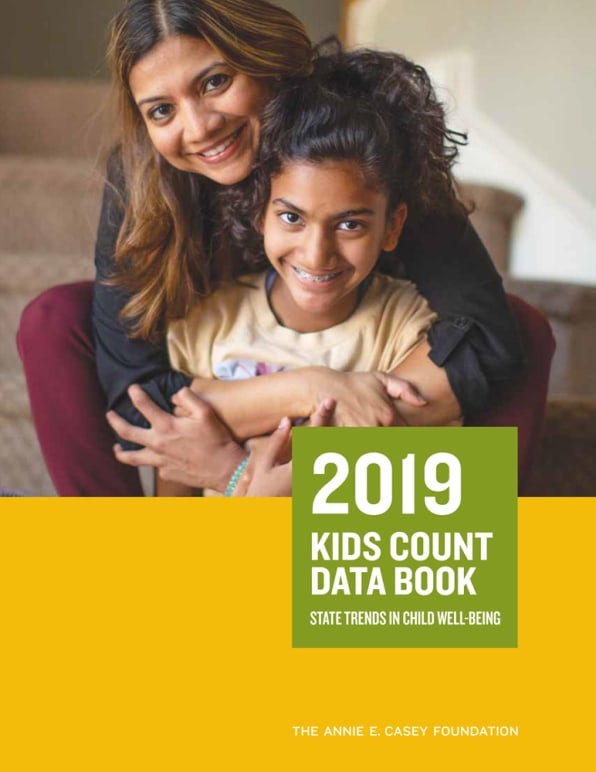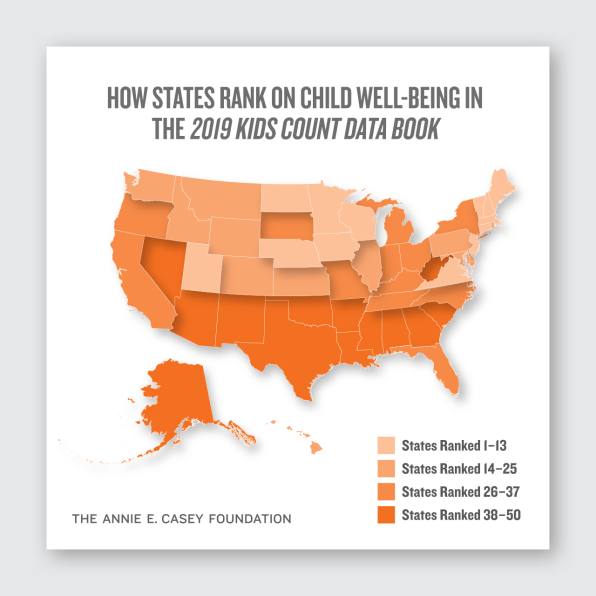A simple measure of societal progress is: “Will the next generation be better off than the current one.” Right now, we seem to be going backwards on that metric. A child born today has around the same chance of growing up in poverty as one born in 1990. “We haven’t seen the progress we’ve wanted to see on reducing child poverty, and part of that is to do with the way our economy is working—even though it’s technically growing, we haven’t seen really significant wage growth,” says Noah Berger, director of policy reform and advocacy at the Annie E. Casey Foundation, which works to improve outcomes for children and families.
Some other challenges facing children born today: A likelihood that they’ll be born with low birth weight, which has been increasing for the past three years; questionable access to insurance, which, though drastically improved since 1990, is starting to slip; an educational system that is not preparing them adequately for the workplace (two-thirds of today’s fourth graders are not proficient in reading); being born at a time when more and more families are struggling to accumulate wealth that could help set kids up for success in their own lives.

In the 30th edition of the Kids Count Data Book, which compiles annual statistics about our nation’s children, the Casey Foundation enumerates the challenges facing us–and the changing demographics of our younger generation. The number of children in the U.S. rose from 64 million to nearly 74 million, and the proportion of children of color increased from 31% to 49%. Around 18 million children in the U.S. now have immigrant parents, or are immigrants themselves. “Clearly, the nation’s future depends on creating opportunity for all kids,” Casey Foundation CEO and president Lisa M. Hamilton writes in the report.
But America has not done that. “We see problems across the board, but children of color face particularly high barriers,” Berger says. Because children of color encounter issues stemming from systemic racism in the U.S. from a young age, they face an uphill battle for the rest of their lives. These inequities impact everything from health outcomes to educational opportunities to long-term stability in terms of housing and employment.

[Image: courtesy Annie E. Casey Foundation]
Focusing on children’s outcomes, as the Casey Foundation does, lends a sharper focus to sweeping issues of inequality that the U.S. must grapple with. But Berger says this is not a hopeless situation. “There are strategies that we know would work to address these issues–things like the earned income tax credit helps millions of low-income working families make ends meet. Both the federal and state governments could expand their EITCs,” he says. Numerous presidential candidates have made similar proposals for using the tax credit, which delivers up to around $7,000 per year to low-income families, to help lift families out of poverty. A dramatically expanded tax credit, which groups like the Economic Security Project (helmed by Facebook cofounder Chris Hughes, Community Change president Dorian Warren, and Aspen Institute Future of Work Fellow Natalie Foster) are pushing for, could help many more families.
Simply raising the minimum wage, which states like California and New York have done, also helps. “When the minimum wage increases, the earnings of low-income families go up, which has a real positive effect on children’s outcomes,” Berger says.
Additionally, more targeted proposals like baby bonds–giving low-income children up to $2,000 annually (which presidential candidate Cory Booker has proposed)–would directly address racial wealth inequity from birth, which could add up to $46,000 per child by the time they turn 18. Given that the median white person aged 18-25 has a net worth of around that, while black youth now have just about $2,900, it’s clear what such a program would do to eliminate this gap.
Better funding for public schools, particularly those that serve children of color, and policies to reduce student debt for college would also go a long way toward supporting children and encouraging them to pursue higher education without the prohibitive costs that weigh on youth today.
Ultimately, Berger says, “children are 25% of our population now, and they’re 100% of our future.” If the U.S. doesn’t begin to advance policies specifically designed to help children thrive now, that future is going to look even more fraught than it does today.
(13)